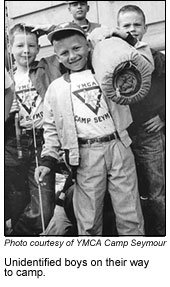Colleen Slater, KP News A few years before the Boy Scouts were organized in the United States, William W. Seymour of Tacoma invited some boys to camp on his Glen Cove property one summer.
A few years before the Boy Scouts were organized in the United States, William W. Seymour of Tacoma invited some boys to camp on his Glen Cove property one summer.
Seymour, an early Tacoma YMCA board member and later president of the Board of Park Commissioners in Tacoma, owned some utilities in Washington and sold land and timber. He was Tacoma’s mayor for several years from 1911.
Seymour apparently loaned the property to the YMCA as an outing center at first.
As early as 1903, a few boys may have camped on the land, but 1905 was selected as the beginning date of the camp because records state that YMCA Physical Director Harry Booth and some boys erected the first tent for a camp that year. The following summer, 16 boys attended camp for two weeks, and by 1908, more than 60 boys were camping, with 10 tents set up. According to a 1973 Tacoma Review article, a cookhouse and dining pavilion were built near the water.
This year, the camp will celebrate its 100-year anniversary with style, launching a variety of activities and events, including a celebration of its fascinating history. The camp will host several special events throughout 2005.
Back in 1905, the camp had no fresh water source, and campers rowed across the cove to obtain needed water from residents there until their own well was dug in 1919.
C. E. “Pops” Drake, who had founded a YMCA camp in New York state, arrived in 1918, and was an important figure in the camp’s direction for the next 20 years, until his death. He apparently encouraged Seymour to deed the property to the YMCA, and within a few years, Camp Seymour consisted of 150 acres. Drake’s title was Boys Work Secretary.
Rich Lodge, the dining hall constructed in 1920, was a gift of Dr. E. A. Rich, grateful for the recovery of his son lost overnight at the end of a hike from Home. The 35-foot fireplace, deemed the tallest in Washington then, was built from 58 tons of white glacial rock ferried in and carried by the campers from ferry to building site. The chimney and building are still a part of the camp.
Boys in 1913 paid $6.50 each for a 10-day camping experience. They elected “city officials” who supervised various areas. Equipment included “four large safe boats.”
By 1920, rustic open cabins with floor and roof replaced the tents used for camping.
Rotary Club sent disadvantaged boys to camp early in its history and has made several donations over the years for general camp improvements and buildings, including the construction of a cabin in 1937.
In preparation for their centennial, a committee of Camp Seymour staff members have been searching through its archives and collecting tidbits of camp history.
Horse stealing was mentioned in connection to hikes to Hood Canal in 1921 and 1934.
African American boys were Camp Seymour campers as early as the 1920s. A ballfield was cleared with 40 blasts of dynamite.
The “Dippy Club” was first noted in 1923 camp notes. Members of this group ran, sans clothing, to dive into the cove. The tradition was maintained, but later required swimwear.
In 1940, the threat of polio closed the camp for the summer.
In 1945, after World War II ended, 32 wounded veterans used the camp for therapeutic recreation and helped with repairs and construction.
Horseback riding was provided by carrying campers by truck to Longbranch.
In 1965 a Labor Day weekend Family Camp was held (still a popular tradition with families), and girls were included among campers by 1975.
Camp Seymour has changed over its 100-year history, but it’s still a place where boys (and now girls, too) can enjoy some special camping experiences.
UNDERWRITTEN BY THE FUND FOR NONPROFIT NEWS (NEWSMATCH) AT THE MIAMI FOUNDATION, THE ANGEL GUILD, ADVERTISERS, DONORS AND PEOPLE WHO SUPPORT INDEPENDENT, NONPROFIT LOCAL NEWS